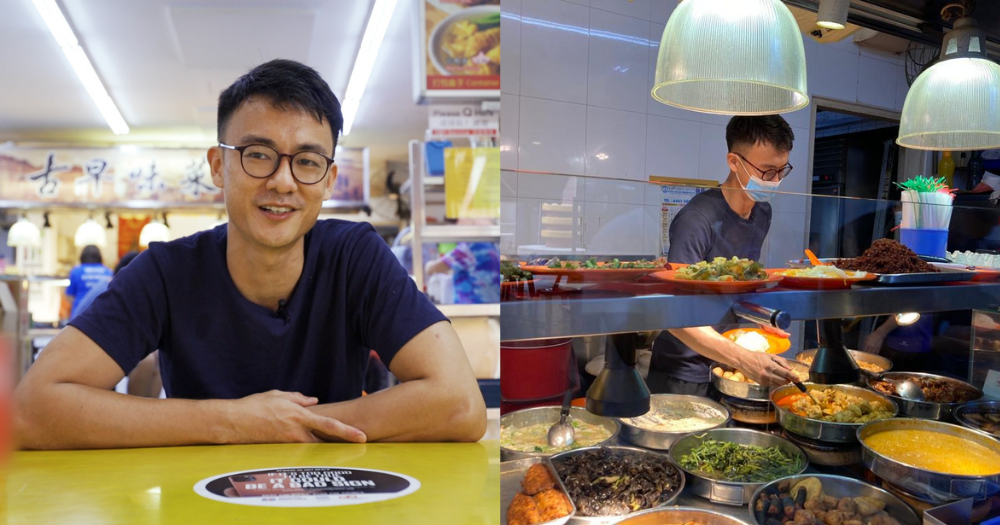Follow us on Telegram for the latest updates: https://t.me/mothershipsg
PERSPECTIVE: How do cai fan (economy rice) sellers know which dish we're pointing to when we don't know their names? How do they calculate the total cost of a plate so quickly? Why do we get charged more even when there's only a bit of meat in a vegetable dish?
These are some of the questions about cai fan we asked Javier Ng, the 29-year-old owner of Gu Zao Wei cai fan in Choa Chu Kang. Here's what he told us.
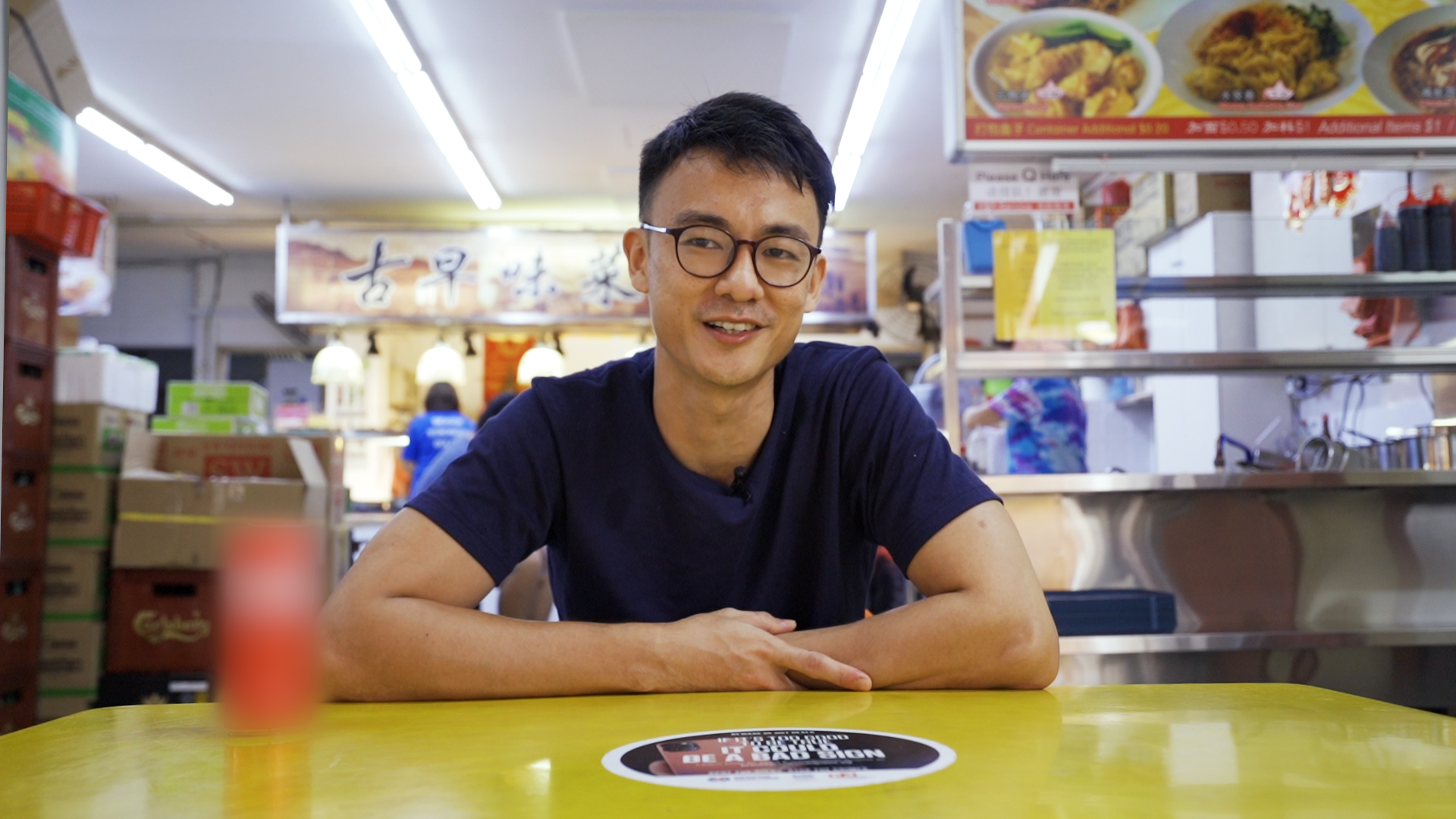 Photo by Abriel Tay.
Photo by Abriel Tay.
How do you decide how to address customers? Like "shuai ge" (handsome guy) like that?
Based on my mood. No, I'm just joking. It's just "auntie", "uncle", or like "lao ban" (boss), "lao ban niang" (lady boss). In the first place, you must respect them, so you call them in a very nice way.
You don't say like, "Oi!" You don't do this kind of thing. You just address them like "sir", "ma'am". Like, basic manners.
Usually "shuai ge" (handsome guy)... everybody likes it. Who doesn't? *asks us* You like being called shuai ge? ("Yeah.") You like being called mei nu (pretty girl), yeah? So why not? You make customers happy, hopefully they spend more. So it's a win-win situation.
I've got this friend and we always joke around. He says every time he eats cai fan, if the guy don't call him shuai ge, he don't wanna eat already. So I take it as a point, like noted! So I would call everybody "shuai ge" or "mei nu".
Even though I have to lie lah. *laughs*
If we call you shaui ge when we're ordering from you, will you give us more food?
No. Why would I? I mean, I know I'm handsome lah, but no. *laughs* Doesn't work that way!
How do you know which is "zhe ge (this)", and which is "na ge (that)"?
Okay, this is a very difficult question. Because sometimes when a customer is there, then they will point and say "zhe ge". Then maybe what they want is the second one in the row, but you take it as the first one because from your angle you cannot see clearly.
So I try to make it a point for my workers to know all the dish. So when customers say "zhe ge" and they point that direction, we name the dish for them.
Because for customers, at some points in time when you're ordering, you know it's sweet and sour pork, but it just doesn't come to your mind. So at least when we say the dish name out, you will know it.
Why are there so many dishes in cai fan?
My question to y'all is, why do you eat cai fan? Because you cannot decide what to eat mah. So obviously, you choose cai fan because there's a lot of dish for you to choose from. So that's why there are a lot of dish in cai fan.
And secondly, it's cheap. You can order as many things as you want — except fish — and maybe not hit S$10 still.
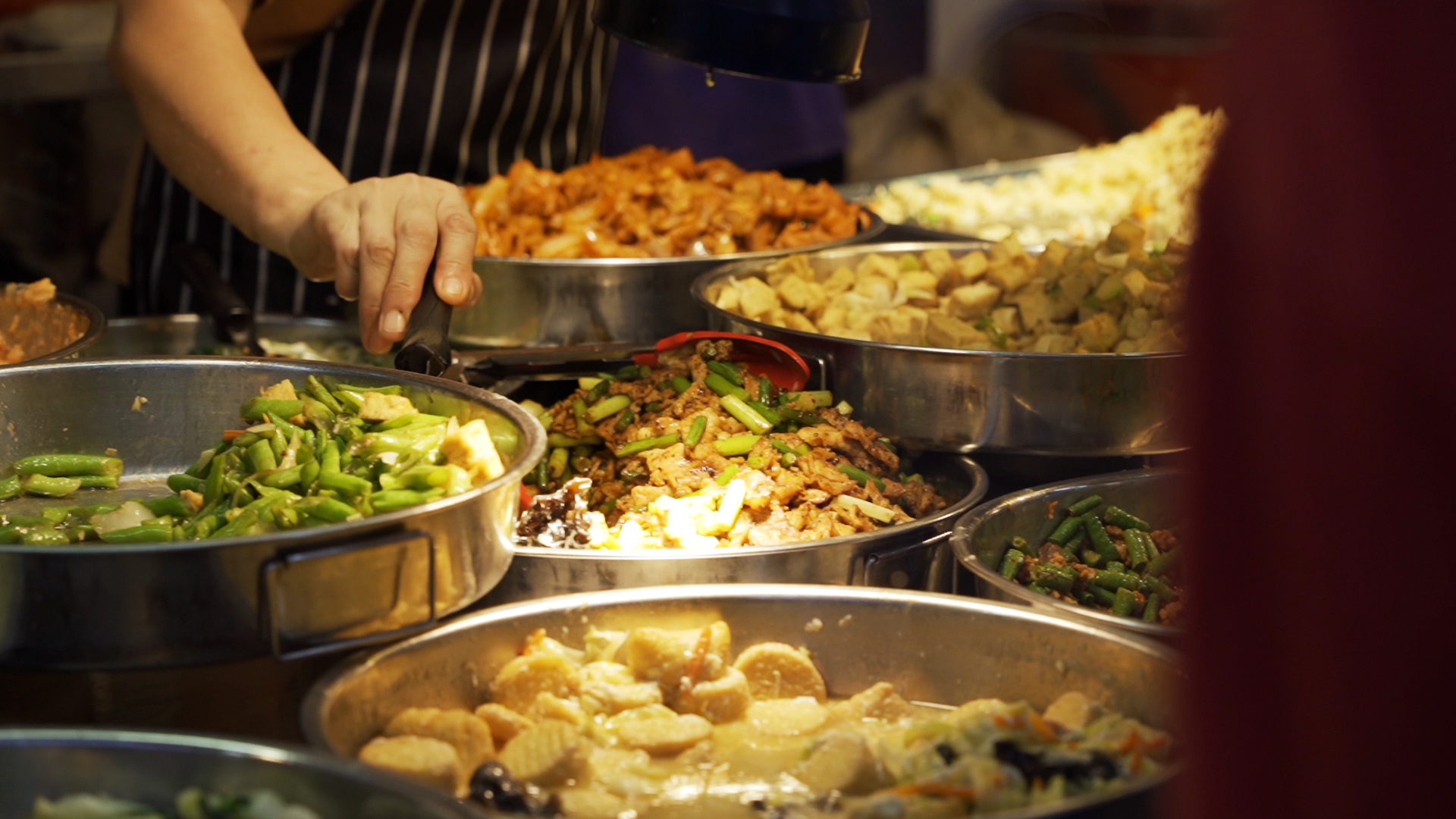 Photo by Abriel Tay.
Photo by Abriel Tay.
Where do you get the recipes from?
YouTube! *laughs* No lah, some things are passed down from my dad because he himself runs his own cai fan stalls. Then some I learned from his workers.
Then along the way, over the years, with YouTube and the internet, you learn more things online. From there, you make some adjustments to what is on YouTube, or what you're seeing online. Because some of the dishes, they use very expensive stuff. Then you have to find another substitute for it.
What's the easiest dish to cook and the hardest dish to cook?
For me, hardest one is taugeh — beansprouts — because there are different ways of cooking beansprouts. Some of the stalls they actually... tang shui (blanch) first, then they just put the soy sauce over it.
But for my stall, I stir fry it. The timing is very important for bean sprout, because the oil must be very hot and when it goes down, the timing matters. If it's overcooked, it's very soggy and it's not nice.
But when it is absolutely on the dot, it's very crunchy and it's just right. For me, that's my personal hardest dish.
Easiest dish ah? I think there's no such thing as easy dish. Because there are some times, like when you're in a bad mood, you just don't feel like cooking. Then everything becomes a very hard dish to cook.
What are the most popular cai fan dishes, that sell out the fastest?
I would say curry chicken is one of the more popular dish, in my case.
It's a very homely dish, so long as it's not too spicy and too salty. I think if there's a fair balance between the curry powder and chilli paste and coconut, it makes curry a very comforting dish. So that's why I feel that it's very popular.
What about the least popular, which always has leftovers at the end of the day?
Leftovers ah? Actually, I don't have leftovers. *laughs*
I would say black fungus. Over the years, I've noticed that some people like it, some people don't like it. There are days where I absolutely sell out, but there are days where I just can tell that maybe I only sold one serving and that's about it.
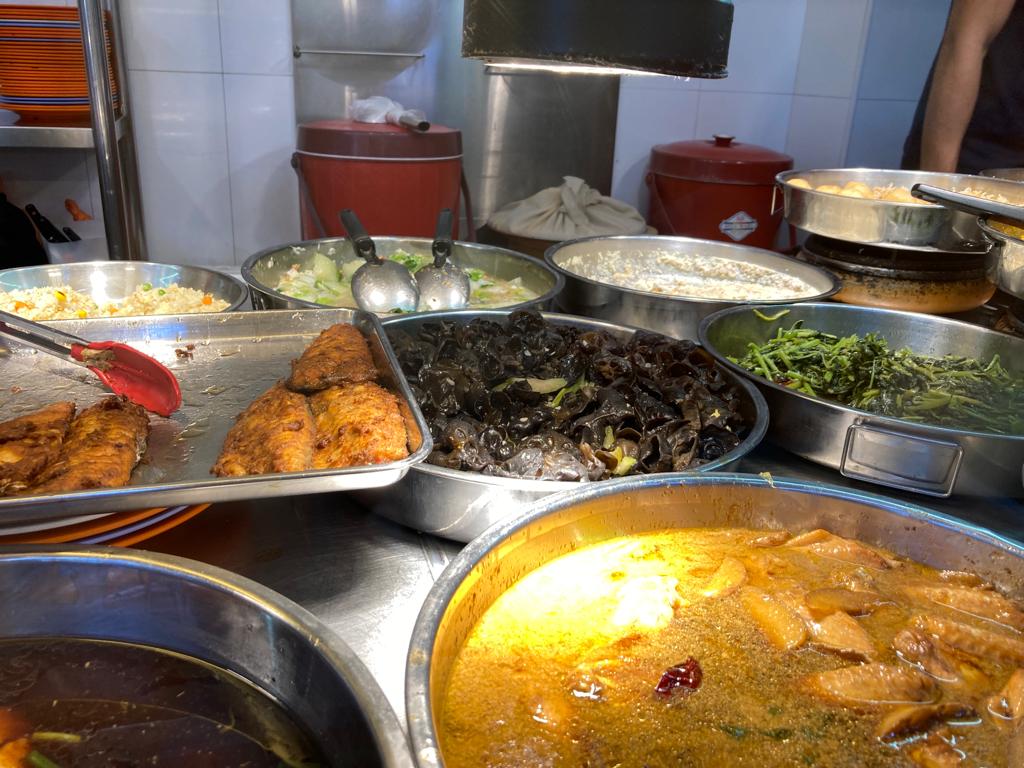 Indeed, there was quite a bit of fungus still available that day. Photo by Jane Zhang.
Indeed, there was quite a bit of fungus still available that day. Photo by Jane Zhang.
Is your most commonly-said phrase "hai you?"("and?")?
Yeah, of course. You want to spur your customer on to keep adding and adding and adding. I mean, it's one trigger.
I mean, you don't say "Hao liao ma? (okay already?)" You don't say, "Finished already anot? 'Wan liao ma?'" I mean, it's like you're pushing your customers away.
Of course, you want to earn more from your customers, so obviously you use "Hai you ma? Hai you ma?"
Do you give standard portion sizes to your different customers, or will you give according to how much they look like they can eat?
No, we just give the same. It's not fair to others mah.
Like imagine there's a queue. So a bigger guy comes, you give him more. Then there's a smaller guy. Maybe the small guy got big appetite, but you don't know. Then he might be like, "How come you gave him so much more?"
I mean, it doesn't make sense lah. So we try to give the same portion throughout. ("Cai fan equality!") Yeah, yeah. Something like that.
How do you remember how much each dish costs?
Muscle memory, I would say.
Out of 40 dishes, maybe 30 is what you have everyday. So after you work a certain amount of time, you'll know that it's that pricing. It won't change, unless you change the price for everything. So you just know it.
But how do you calculate the total cost of the order so quickly?
It just happens lor. I cannot answer that because it just happens for me. Like if customers don't mix up their orders, like don't jumble up, then it's very clear cut. Two veg, one meat — three dollars. Like that kind of thing.
Growing up, was your mental maths very good?
I would say yeah. It does help a bit. Because I've encountered workers who, even though they've been with me for one or two months, the basic "two veg one meat three dollars" kind still cannot get it one.
Some people might think that the pricing of cai fan is agak-agak (estimate). Is that true?
No lah, why would it be agak-agak? There is no such thing as agak-agak. Whatever you order, we already set the price beforehand. If there's price changes, we will alert the customers.
For my case, there are some dish that are S$1.50 and some are S$2. Then some of the meat are just S$1.10. So I will tell customers if it's slightly more expensive than the usual price.
Like if maybe they order some S$2 meat, I make it a point to tell my customer, "This is gonna cost you S$2 for this serving. Is it okay?" Some will just take it, but some will say, "I don't want" and then you change lor.
True or false? There’s no additional charge when you ask for “duo yi dian fan (a bit more rice)” instead of “jia fan (add rice)”.
False. So, my question to you: "duo yi dian (a bit more)" means "jia (add)", right? Yeah lah! So you have the answer.
Usually I'll make it a point to tell customers, "'Duo yi dian' shi bu shi 'jia'? (Does 'a bit more' mean 'add'?)" Then if they say yes, then jia lor. If no, then you just tell them nicely lah.
Most of the time, people just accept it, they understand one — most of the time, but of course there's that 1 per cent.
So cannot try our luck?
Can lah, why cannot? Like maybe lao ban good mood, then it'll be like, "sui bian lah, sui bian (anyhow)". But it usually doesn't work that way.
True or false? If there’s minced meat in a veggie dish, it will be charged as a meat dish.
True, because it's still meat what. I mean minced meat is meat right?
What if I don't want the minced meat and just want the veg?
I mean, we already cooked it together, so taking them apart is, number one is time-wasting, and number two is like impossible. Imagine we cooked long bean with minced pork. Then you expect us to take out one by one? It's not possible what.
What about vegetable dishes with fish cake? Is it a meat dish?
I would say yes. Because fish cake is made from what? Fish what. Is fish a meat? Yeah.
True or false? You get a larger portion when you point at a dish longer or many times.
Definitely false. It doesn't work that way. For me, it's like, when you point at it, I'll take one serving, which I feel is a fair portion.
And then if you keep pointing, then I'll ask "hai you?" and you will just move on. If you're still pointing, I'll just ask you, "You want to add more?" If you say yes, then I add another portion. If you say no, then "Okay, hai you?"
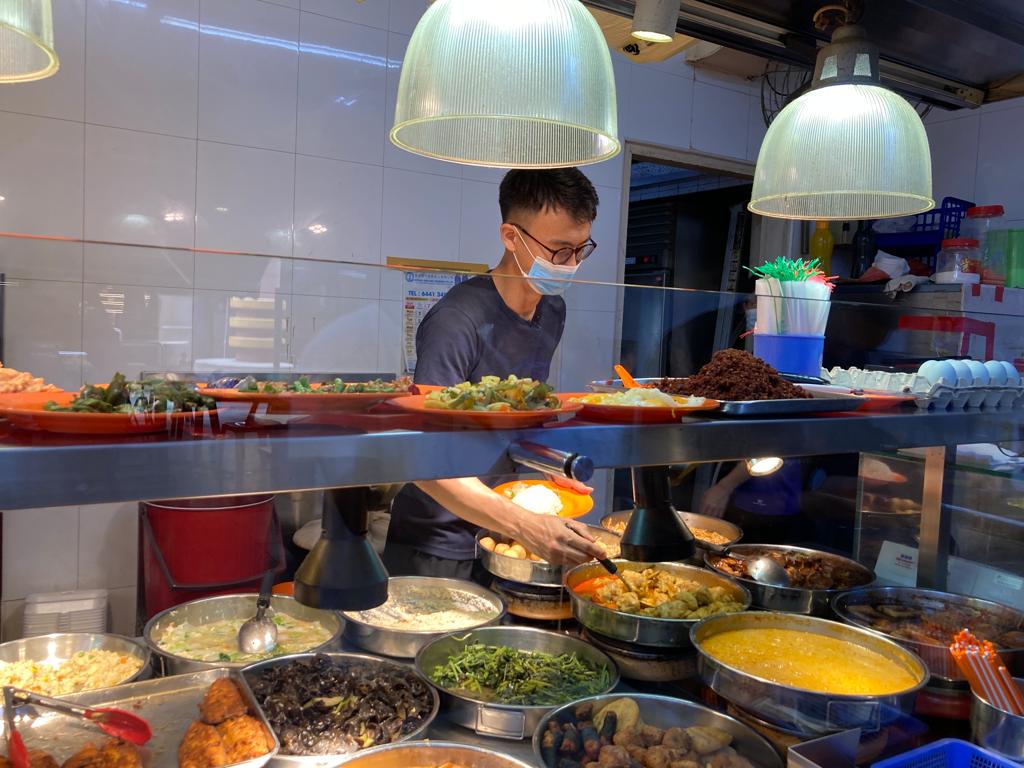 Photo by Jane Zhang.
Photo by Jane Zhang.
Do people get more or less food if they bring their own containers?
I would say the same, because our target is to give equal portion for everything. But then again, there are customers that bring super small containers, then they ask for "shao yi dian (a little less)", then obviously it looks lesser lah.
Then there are people that bring super huge containers, then they expect us to give them more because by the time we serve finish, in the container it looks very little.
Then we just have to explain to them: "Auntie, this is my styrofoam box. This is your container. See the size of your box and my box, the difference?" Then they say, "Yeah, tai guo fen liao (so unfair). Then you ask them nicely, "Ni yao jia ma? (You want to add?)" That's about it.
Is the food at night less fresh than the food during lunch?
No, no, no, no, no. Because food will turn sour after too long. So usually, night food is prepared in the afternoon, and noon food is prepared in the morning.
When we hit a certain time — for my case, the time is 3pm — I will throw everything. Then I will cook a new batch.
For us, we also have consider the fact that, what if we are the consumers? We also don't want to eat less fresh stuff, so we'll throw it away. Being socially responsible, I would say.
Why do y'all always like to use the tong to hit the plate?
Number one is to get your attention, because sometimes when customers are ordering, they daze away or look at other dishes. So it's to get back your attention.
Then another reason might be... because we are angry. *laughs* Maybe you're annoying us lor.
Do you have any "hacks" for how to order cai fan like a pro?
Know your dishes. When you come, know what you want to eat. Don't queue join the queue first. Stand at the back to see what you really want. Then when you're in the queue, it'll straightaway come to your mind what you want, and you'll just order.
For me, I prefer my customers to be like that. Because some of them, they come and they queue and then they take their own time and they think, think, think. Whereby maybe I could have sold another five plates already, and then finally they are done.
So it's a bit time-consuming, I would say. Because cai fan, from my own understanding, is meant to be quick. So to be a pro you must be quick lah.
Do you eat your own cai fan?
Yeah, of course! Every day, just to save money lor, so that I can spend on my wife.
On a more serious note, of course I eat it every day. Because number one, it's free. Number two, to know whether my food is up to standard on the day itself.
You never get sick of it?
I would say no, because every day I try to eat different stuff. I mean, there's over 30 to 40 dishes, so every day I just eat three or four for lunch, then I still got the remaining that I can eat for dinner. So I go on everyday trying new stuff.
What's your favourite dish?
I would say bitter gourd – ku gua. Why bitter gourd? Maybe because... I don't know, from young my dad made me eat. Ever since then, I've been hooked on it.
What does cai fan mean to you?
Cai fan to me is everything, because I grew up eating cai fan. I grew up in a cai fan family. I grew up with a lot of cai fan people: my dad, his workers, my family line. My mom's brother — my uncle — also runs cai fan. So it's like, everything is cai fan to me.
Visit Ng’s cai fan stall, Gu Zao Wei, at Keat Hong Market, 253 Choa Chu Kang Avenue 1.
Read our interview with Ng here:
Follow and listen to our podcast here
Top photos by Abriel Tay and Jane Zhang. Some quotes have been edited for clarity.
If you like what you read, follow us on Facebook, Instagram, Twitter and Telegram to get the latest updates.
